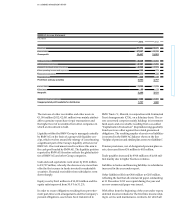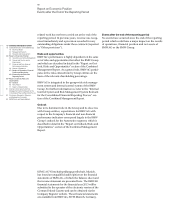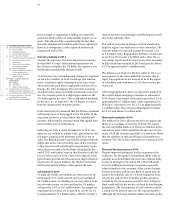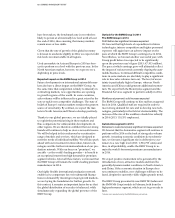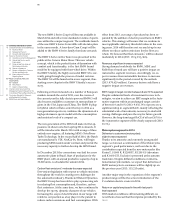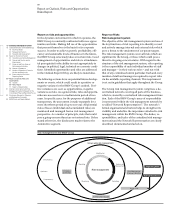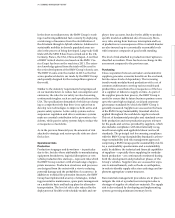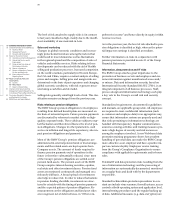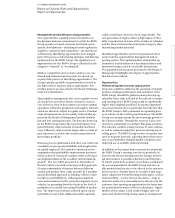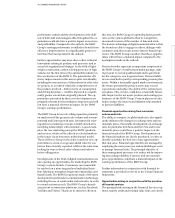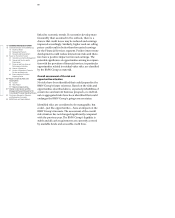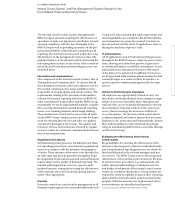BMW 2013 Annual Report Download - page 71
Download and view the complete annual report
Please find page 71 of the 2013 BMW annual report below. You can navigate through the pages in the report by either clicking on the pages listed below, or by using the keyword search tool below to find specific information within the annual report.
71 COMBINED MANAGEMENT REPORT
In the short to medium term, the BMW Group is work-
ing on achieving additional fuel economy by deploying
a wide range of measures from the electrification of
the drivetrain through to hybrid solutions. Solutions for
sustainable mobility in densely populated areas are
also
in the process of being developed. Large-scale field
trials with the MINI E have been carried out in the UK,
Germany, France, the USA, China and Japan. A test fleet
of BMW ActiveE electric cars based on the BMW 1 Se-
ries Coupé has been on the road since 2011. The exten-
sive knowledge gained from the trials will be used in
the series development of the BMW Group’s electric cars.
The BMW i3 came onto the market in 2013 as the first
series-produced electric car made by the BMW Group
and specially designed for the metropolitan regions of
the world.
Similar to the statutory requirements being imposed
on car manufacturers to reduce fuel consumption and
emissions, the rules for car safety are also becoming
continuously tougher, such as crash specifications in the
USA. The specifications demanded of vehicles are chang-
ing
so comprehensively that there is no option but to
develop new technologies to improve both active and
passive safety systems. Active safety systems such as
suspension regulation and driver assistance systems
make an essential contribution to the prevention of ac-
cidents, while passive safety systems help to reduce the
consequences of accidents.
As in the previous financial year, the amounts of risk
attached to strategic and sector-specific risks are classi-
fied as low.
Operational risks
Production
Production stoppages and downtimes – in particular
due to fire, but also those attributable to manufacturing
equipment breakdowns, logistical disruptions or new
vehicle production line start-ups – represent risks which
the BMW Group counters with a broad range of
appro-
priate measures. Production structures and processes
are designed from the outset with a view to reducing
potential damage and the probability of occurrence. In
addition to technical fire protection measures, the BMW
Group has implemented an array of strategies, includ-
ing preventative maintenance, spare parts management
on a multi-site basis and back-up plans for alternative
transportation. The level of risk is also reduced by the
deployment of flexible work-schedule models and em-
ployee time accounts, but also by the ability to produce
specific models at additional sites if necessary. More-
over, risks arising from business interruption and loss
of production as a consequence of fire or natural disaster
are also insured up to economically reasonable levels
with insurance companies of good credit standing.
The level of risk attached to production interruptions is
classified as medium. There has been no change in this
assessment compared to the previous year.
Purchasing
Close cooperation between carmakers and automotive
suppliers generates economic benefits on the one hand,
but also raises levels of dependency. The increasing
trend towards modular-based production
with a set of
common architectures covering various
models and
product lines exacerbates the consequences
of the loss
of a supplier or failure to supply on time. As
part of
the supplier preselection process, the BMW Group is
careful to ensure that its future business partners come
up to the same high ecological, social and
corporate
governance standards by which the BMW
Group is
generally measured. Suppliers are assessed on the basis
of the BMW Group Sustainability Standard which is
applied throughout the worldwide supplier network.
This set of fundamental principles and standards covers
both production and non-production aspects relevant
for the goods and services provided by suppliers, which
also includes compliance with internationally recog-
nised
human rights and applicable labour
and social
standards. The principal tool for ensuring
compliance
with the BMW Group Sustainability Standard is a three-
stage sustainability and risk management approach
comprising a BMW Group-specific sustainability risk fil-
ter, a sustainability questionnaire and a sustainability
audit. In addition, the technical and financial capabilities
of suppliers – especially those supplying for
modular-
based production – are continuously monitored
during
both the development and production phases of the
Group’s vehicles. Supplier sites are assessed
for expo-
sure to natural hazards, such as floods or earthquakes,
in order to identify supply risks at an early stage and im-
plement appropriate countermeasures.
Raw materials management procedures are in place to
mitigate the risk of a production interruption due to
shortages of supplies of critical raw materials. The supply
risk is also reduced by developing and implementing
systems governing minimum inventory levels.


